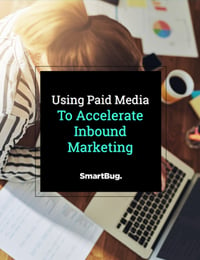
The Beginner’s Guide to Developing a Paid Search Strategy in 2023
June 12, 2023
As a business owner or marketer, you know that paid search advertising has the power to drive targeted traffic to your website. But it can be tough to know how to harness that power.
In this blog post, we will explore the key steps and best practices for creating an effective paid search strategy that maximizes your ROI and helps you achieve your business goals. Whether you're new to paid search or looking to refine your existing strategy, we’ve got the foundational knowledge you need to succeed in 2023.
Understanding Paid Search Strategy
Paid search strategy refers to the systematic approach used to plan, implement, and optimize paid search campaigns. It involves selecting the right keywords, targeting the right audience, setting a budget, and optimizing campaigns for maximum performance. A well-developed strategy can help you reach your target audience at the right time, generate qualified leads, increase brand visibility, and ultimately drive conversions.
Search engines will determine the quality of your ads based on some of the following considerations:
Bidding
When implementing a paid search strategy, businesses bid on specific keywords or phrases that are relevant to their products or services. Advertisers bid by setting the maximum amount they are willing to pay for a click on their ad. When a user enters a search query that matches the keywords an advertiser has bid on, an auction takes place.
The cost of each click on an ad, known as the cost per click (CPC), is influenced by the bidding competition. Advertisers only pay when someone clicks on their ad, hence the term "pay-per-click (PPC) advertising.”
Extensions
Extensions are additional pieces of information or features that can be added to a search ad to give users more context, value, and options. Here are some commonly used ad extensions:
- Sitelink extensions: These extensions allow advertisers to include additional links within an ad, directing users to specific webpages.
- Call extensions: Users can directly click or tap on the phone number in a call extension to make direct contact with the advertiser.
- Location extensions: Location extensions display the business's address alongside the ad, making it easier for users to find and visit the physical location.
- Callout extensions: Callout extensions allow advertisers to highlight specific features, benefits, or offers in an ad.
- Review extensions: Review extensions showcase positive reviews, ratings, or testimonials from reputable sources.
- Price extensions: Price extensions show a list of products or services along with their respective prices.
Quality of Ads and Landing Pages
Google assesses your ads and landing pages and assigns a quality score based on their usefulness and relevance.
A well-designed and optimized landing page is essential for converting paid search traffic into leads or customers. Ensure that your landing page aligns with the ad copy and offers a seamless user experience. Landing page experience, ad relevance, and click-through rate will determine your ad rank.
Focus on clear and persuasive messaging, compelling visuals, and a prominent CTA. Optimize page load speed and mobile responsiveness to cater to the growing number of mobile users.
Keywords
The use of keywords in your ads—as well as the frequency of use—can impact your search engine rankings. Keyword research forms the foundation of any successful paid search strategy. Begin by identifying relevant keywords your target audience is likely to search for, and then use keyword research tools to determine the search volume, competition, and relevance of each keyword. Once you have a list of potential keywords, categorize them based on their intent.
There are different types of keywords: informational, commercial, transactional, and more. Note that this categorization will help you tailor your ads and landing pages for maximum relevance.
Why Paid Search Should Be Part of Your Marketing Strategy
Your digital marketing strategy can benefit from paid search. Here are a few reasons why:
- Paid search helps you get instant traffic to your website.
- You have control over how much money you want to spend on paid search campaigns.
- You can meet potential customers where they’re spending their time online.
- Well-optimized paid search accounts can significantly increase the effectiveness of your overall marketing portfolio.
Steps to Creating a Successful Paid Search Campaign
By now, you’re likely convinced of the importance of paid search for your 2023 marketing strategy. If you’re ready to get started on a paid search campaign, here are some steps to follow.
1. Set Goals and Define Key Performance Indicators
Before diving into the nitty-gritty of your paid search strategy, it's crucial to define your goals and key performance indicators (KPIs). Are you looking to increase website traffic, boost sales, generate leads, or enhance brand awareness? By setting clear and measurable goals, you can align your strategy with your business objectives and track your progress effectively.
2. Choose Match Types
Match types in paid search refer to the options advertisers have to control the reach and specificity of their keyword targeting. Match types determine how closely a search query needs to match the keywords in an advertiser's campaign for their ad to be eligible to show.
The main match types commonly used in paid search advertising are below.
Broad Match
Ads are eligible to show for search queries that include variations, synonyms, related terms, and other relevant variations of the target keywords. Broad match offers the widest reach but may result in imprecise targeting.
Modified Broad Match
By adding a "+" symbol in front of one or more keywords, advertisers can indicate that these keywords must be present in the search query for the ad to be eligible. This match type offers more control than broad match while still allowing for some variation.
Phrase Match
Ads are eligible to show for search queries that include the target keywords in the right order, but queries can have additional words before or after the phrase. Phrase match provides more precise targeting than broad match while still allowing for some flexibility.
Exact Match
Ads are eligible to show only for search queries that match the target keywords exactly or are close variations. Exact match offers the highest level of control and precision.
3. Implement Conversion Tracking and Analytics
To evaluate the success of your paid search strategy, it's crucial to implement conversion tracking and analytics. Set up conversion tracking codes on your website to measure key actions such as form submissions, purchases, or downloads. Leverage analytics platforms such as Google Analytics to gain insights into your campaign performance, track important metrics, and make data-driven optimizations. Your metrics and KPIs will vary depending on the stage of the buyer’s journey you want to focus on.
4. Create Your Ad Copy
This is arguably the most important part of creating any paid search campaign, and it requires a few sub-steps.
Craft an Engaging Headline
The headline is the first thing users see, so make it attention-grabbing. Highlight your unique selling proposition (USP) or present an enticing offer. Use strong, action-oriented language and make it relevant to the user's search query.
Write Compelling Ad Copy
In the ad body, emphasize the benefits and value of your offering. Keep copy concise, clear, and focused. Include keywords where natural, but avoid keyword stuffing. Use persuasive language to evoke interest and emotion.
Create a Strong Call to Action (CTA)
End your ad with a clear and compelling CTA that encourages users to take action. Use action verbs and specify what action you want users to take, such as "shop now," "sign up today," or "get a free quote."
Ensure Relevance and Alignment
Align your ad copy with the landing page you're directing users to. Ensure the messaging, keywords, and offers in your ad are consistent with the landing page content. This improves the user experience and increases the chances of conversions.
5. Test, Optimize, and Scale
Keep in mind that a good paid search strategy is an iterative process that requires continual testing, optimization, and scaling. Monitor your campaigns regularly and analyze the performance data to identify areas of improvement. Test different ad variations, landing page elements, bidding strategies, and targeting options to refine your strategy. As you gather insights and achieve positive results, consider scaling your budget and expanding your reach to maximize your return on investment.
Let’s Wrap This Up
Mastering the art of developing a paid search strategy in 2023 is crucial for businesses that want to thrive in the digital landscape. By grasping the fundamentals of keyword research, ad creation, targeting, and optimization, you have the power to reach your target audience effectively and achieve your marketing objectives.
Now that you’re armed with this beginner's guide, it's time to dive in and start developing your paid search strategy. Harness the power of paid search to elevate your online presence, connect with your target audience, and achieve your business goals in 2023 and beyond.
About the author
Viole Morales Viole Morales is a passionate marketer from El Salvador. With over 9 years of experience in digital marketing, customer success, and account management, she enjoys learning new marketing trends, managing and cultivating good relationships with her clients, and enabling them to achieve their goals through digital marketing strategies. Read more articles by Viole Morales.




















